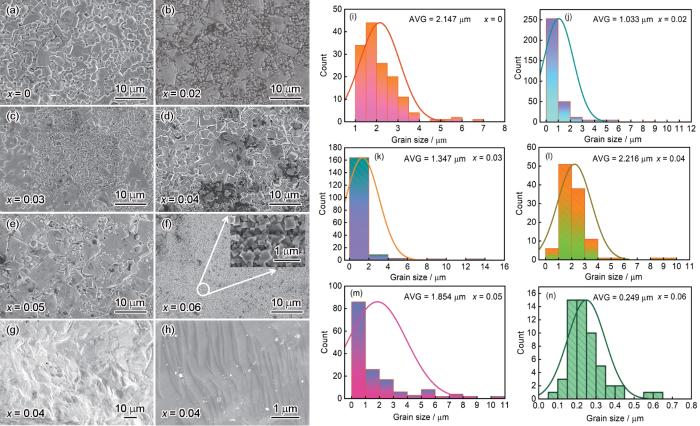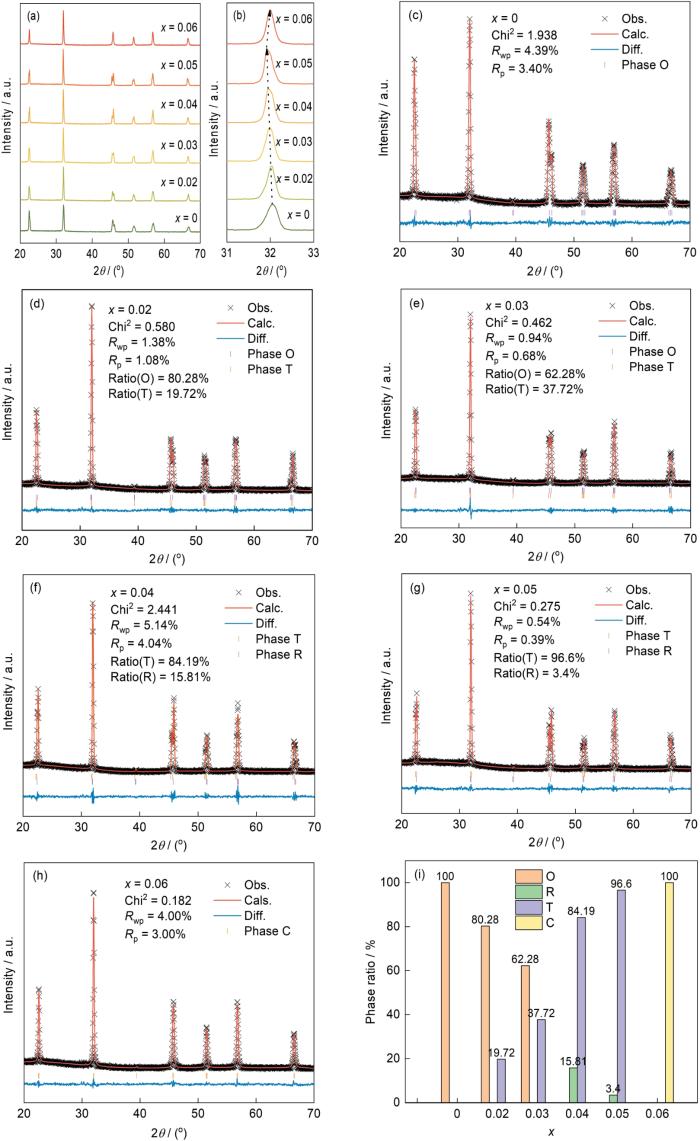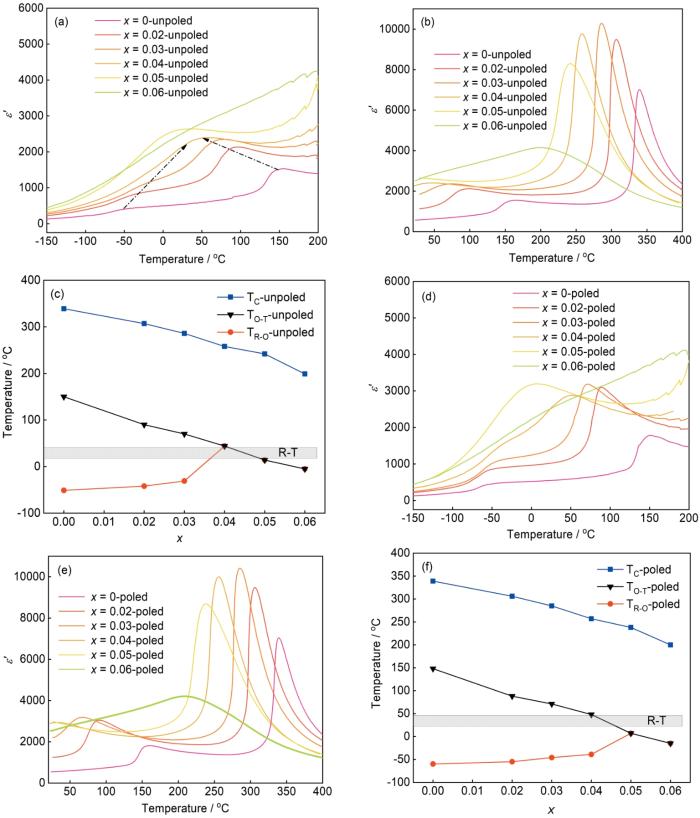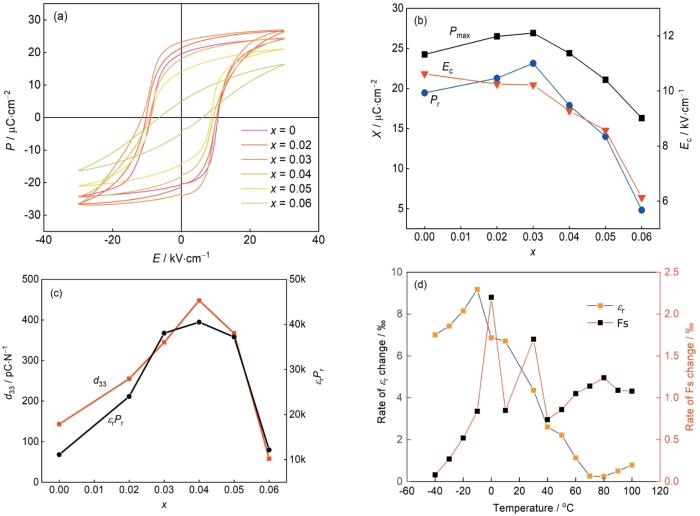压电陶瓷是一类重要的功能材料,可将电能与机械能相互转换[1,2]。锆钛酸铅(PZT)基压电陶瓷具有优异的压电性能,但是其中的铅危害环境和人体健康[3]。铌酸钾钠(KNN)基无铅压电陶瓷具有良好的压电性能且环境友好,受到了极大的关注。但是,纯相铌酸钾钠陶瓷的居里温度Tc = 415℃,压电性能参数为d33 = 125 pC/N,kp = 0.40[4],表明其性能远不如PZT陶瓷。2004年日本Y.Satio用反应模板定向生长法(TGG)制备的正交-四方(O-T)两相共存的锂钽锑共掺杂KNN基织构陶瓷,其压电常数d33为416 pC/N,机电耦合系数kp达到0.61[5],可与商业PZT媲美。翟继卫等用TGG法制备了组分为0.96(K, Na)(Nb, Sb)O3-0.01CaZrO3-0.03(Bi, K)HfO3的织构陶瓷,其压电常数达到了惊人的700 pC/N[6]。可用Li+部分代替A位的Na+/K+,或者用Sb5+代替B位的Nb5+以使O-T相变移动至室温,得到极高的d33[7,8]。将(Bi, Na)ZrO3或(Bi, Na)HfO3等ABO3型氧化物掺入(K, Na)NbO3或(K, Na)(Nb, Sb)O3中,可使其O-T相变点下移或R-O相变点上移[9~15],进而压缩O相温度区间使其在室温发生R-T相变[15~18],提高陶瓷的d33[16~24]。
1 实验方法
1.1 样品的制备
用固相法制备KNN基陶瓷 (1-x)K0.48Na0.52Nb0.96Sb0.04O3-x(Bi0.5Na0.5)ZrO3陶瓷(简称为 KNNS-xBNZ),其中x = 0、0.02、0.03、0.04、0.05、0.06。使用的原料有K2CO3(纯度99.0%)、Na2CO3(纯度99.8%)、Nb2O5(纯度99.5%)、Sb2O3(纯度99.99%)、ZrO2(纯度99%)以及Bi2O3(纯度99.999%)。
先将K2CO3和Na2CO3置于200℃烘箱中去除水分,再按照化化学计量比称量原料。将称好的原料置于球磨罐中,以无水乙醇为介质用行星式球磨机(QM-3SP2)球磨15 h。将球磨好的原料取出烘干过筛,然后置于坩埚中进行合成。陶瓷的合成温度为900℃,保温时间为6 h;将合成后陶瓷粉二次球磨15 h,然后将其烘干过筛并加入3%的聚乙烯醇PVA粘结剂进行造粒。使用钢模具在8 MPa的压力下将粉料压成直径为10 mm、厚度为1 mm的圆片。在650℃排胶2 h后将陶瓷片置于高温炉中进行烧结。用两步法烧结:先以15℃/min的速率升温至1200~1220℃,保温5 min后迅速降温到1090~1120℃,保温20 h后自然降温,在制备出陶瓷片样品。将陶瓷片两面涂银后在780℃保温30 min进行烧银。然后在室温下进行极化,极化电场为3 kV/mm,静置24 h后测试电学性能。
1.2 性能表征
用阿基米德排水法测量陶瓷的实际密度ρ,其致密度为ρ/ρ0,而
为理论密度。其中m为样品相的数量,M为相对分子质量;V为晶胞体积;NA为阿伏伽德罗常数;n为单胞分子数;F为相体积比例。
用X'pert pro型X射线衍射仪(XRD)分析陶瓷的相结构,测试条件为:Cu靶Kα射线,电压为40 kV,电流为0.40 mA,扫描范围为20°~70°,测试步长为0.0167°,扫描速度为10 (°)/min。用LabRAM HR Evolution型超低波数拉曼光谱测试仪测试样品的拉曼光谱,入射光波长λ = 532 nm。用Hitachi S-4800型扫描电子显微镜(SEM)观测陶瓷表面和断面形貌。用Tecnai G2 F30,FEI型透射电子显微镜(TEM)测试陶瓷的内部微区结构。用ZJ-6A9型d33测试仪测量压电常数。用PV520A型阻抗分析仪测试平面机电耦合系数、机械品质因数。用Radiant PremierⅡ型铁电测试仪测量室温电滞回线,测试频率1 Hz,测试电场30 kV/cm。用TZDM型介电温谱测试系统测试陶瓷介电常数随温度的变化,测试频率10 kHz,升温速率3℃/min。串联谐振频率Fs的温度稳定性用频率温度变化率
表征。其中,TFs为串联谐振频率Fs的温度系数(单位为℃-1),Fs为串联谐振频率(单位为Hz),
2 结果和讨论
2.1 无铅压电陶瓷的形貌和结构
图1给出了不同组分的铌酸钾钠-锆酸铋钠体系无铅压电陶瓷的SEM形貌和晶粒尺寸分布。从图1a~f可见,随着BNZ组分含量的提高晶粒长大,尺寸分布更均匀,陶瓷表面趋向于致密化。x = 0.04的陶瓷中出现个别较大的晶粒,说明晶粒发生了异常长大,晶粒的平均尺寸为2.216 µm,达到最大值,如图1l所示。密度测试结果表明,x = 0.04陶瓷样品的相对密度最大,高达97.43%。这表明,0.04BNZ样品最为致密。从图1g、h也可见,0.04BNZ样品的截面紧密,气孔较少,致密度高。x >大于0.04的陶瓷,其晶粒的平均尺寸逐渐减小,相对密度逐渐降低,致密度逐渐变差。BNZ的含量,影响陶瓷内部晶粒的尺寸和致密度。一定程度的BNZ掺杂可使陶瓷的晶粒逐步变大且分布更加均匀,使致密度提高。这有利于消除自发极化产生的内应力,极化时有助于畴壁偏转,进而提高其压电性能。详细的压电性能参数在图2中给出。经过两步烧结后的未掺杂BNZ组分的KNN陶瓷,虽然其晶粒尺寸较大但是相对密度较低即致密度较低,不利于其压电性能的提高。
图1
图1
不同BNZ含量的铌酸钾钠-锆酸铋钠无铅压电陶瓷的SEM形貌和晶粒尺寸分布以及平均粒径尺寸
Fig.1
SEM and grain size distribution of potassium sodium niobate-bismuth sodium zirconate lead-free piezoelectric ceramics with different BNZ contents (a~f) SEM images of the surface; (g, h) x = 0.04 section SEM; (i~n) size distribution
图2
由图2d可见,x = 0.04的陶瓷其相对密度取最大值。随着x的增大样品的相对密度呈现先增大后减小的趋势,与SEM测试结果相吻合。压电测试结果表明,x = 0.04陶瓷的压电常数为463 pC/N,达到本体系的最大值,且其压电性能和居里温度是同类型无铅压电陶瓷中较高的;综合性能良好,如图2e所示。平面机电耦合系数kp反映薄片沿径向伸缩振动时机械能与电能之间的耦合参数,与剩余极化强度Pr相关。Pr越大则其kp也越大。随着BNZ含量的提高kp呈现先增大后减小趋势,在x = 0.03取最大值0.59。但是,压电常数的大小还与介电常数有关。机械品质因数Qm是指压电振子谐振时克服内摩擦消耗的能量。本文制备的陶瓷其Qm与极化程度和畴壁的运动有关。极化程度较高,Qm也较大。但是,文献[37]认为,畴壁的运动使Qm降低。当x在0~0.04范围变化时,随着BNZ含量的提高畴翻转与畴壁运动更加灵活,极化时电畴更加容易翻转达到饱和状态,因此Qm降低。畴壁运动对Qm的影响是主要的,也说明为何x = 0.04时d33取最大值。而BNZ含量大于0.04的样品中缺陷增加,大量空间电荷因钉扎而束缚电畴的运动[38],使Qm升高。同时,相共存度的降低也使畴难以反转,使d33下降和Qm升高。
2.2 陶瓷的相结构
图3给出了样品的室温XRD谱。从图3a可见,不同含量BNZ体系的压电陶瓷与纯相铌酸钾钠陶瓷的衍射峰相同,表明都是典型的钙钛矿结构,没有杂相。随着BNZ含量的提高,x = 0.02和0.03的陶瓷在室温下处于O-T相共存状态,T相的比例随着BNZ含量的提高而增大;x = 0.04和0.05的陶瓷在室温下R-T相共存;x = 0.02~0.05的样品均处于两相共存状态,表明本文制备的样品具有多型相界。图3b给出了
图3
图3
不同x的铌酸钾钠-锆酸铋钠无铅压电陶瓷的室温XRD谱、精修和相比例分布
Fig.3
XRD and Rietveld refinement pattern at room temperature of KNN-xBNZ ceramics (a) XRD spectrum; (b) locally amplified XRD pattern of 2θ = 32°; (c~h) Rietveld refinement pattern for x = 0~0.06; (i) phase proportion distribution of x = 0~0.06
为了进一步确定两相共存陶瓷样品的相结构和晶胞参数,使用GSAS软件对x = 0~0.06样品进行Rietveld精修,得到了精修图谱以及各相占比和对应的晶胞参数,如图3c~h和表1所示。可以看出,参与精修的所有样品其计算曲线与测试曲线吻合较好,Rwp均小于15%,说明精修的结果可靠。由图3i可见,随着BNZ组分的增加,x = 0.02~0.05的样品中T相的占比逐渐升高,x = 0.05的陶瓷T相的占比最大,为96.6%。BNZ组分达到0.04时由O-T相共存转变为R-T相共存,表明BNZ的引入降低了O-T相变温度和提高了R-O相变温度。这一结果与XRD谱和介温结果吻合。表1中的晶格常数表明,BNZ的持续掺杂使氧八面体扭曲,T相发生轻微的晶格畸变,x = 0.04时c/a达到最大。晶胞的c/a比值大,则可贡献的电偶极矩较高,陶瓷的压电性能最好[39]。x =0.06的陶瓷其畴的长程有序性遭到破坏,在2θ =45.5°只有一个衍射峰,表明出现了伪立方相,使压电性能急剧降低[10,40]。
表1 x = 0~0.06陶瓷样品的晶胞参数以及T相的c/a值
Table 1
| x | 0 | 0.02 | 0.03 | 0.04 | 0.05 | 0.06 | ||||
|---|---|---|---|---|---|---|---|---|---|---|
| Phase | O | O | T | O | T | R | T | R | T | C |
| Ratio/% | 100 | 80.28 | 19.72 | 62.28 | 37.72 | 15.81 | 84.19 | 3.4 | 96.6 | 100 |
| a/nm | 0.3935 | 0.3961 | 0.3979 | 0.3965 | 0.3972 | 0.3965 | 0.3971 | 0.3988 | 0.3974 | 0.3978 |
| b/nm | 0.5630 | 0.5641 | 0.3979 | 0.5639 | 0.3972 | 0.3965 | 0.3971 | 0.3988 | 0.3974 | 0.3978 |
| c/nm | 0.5654 | 0.5652 | 0.3999 | 0.5646 | 0.4002 | 0.3965 | 0.4002 | 0.3988 | 0.4000 | 0.3991 |
| c/a | - | - | 1.0050 | - | 1.0076 | - | 1.0078 | - | 1.0065 | |
图4a给出了不同BNZ组分掺杂样品的拉曼谱。所有样品NbO6八面体的振动标记为1A1g(ν1) + 1Eg(ν2) + 2F1u(ν3, ν4) + F2g(ν5) + F2u(ν6)[41],其中ν1和ν2拉曼位移分别为对称和反对称拉伸模式,ν5拉曼位移为弯曲模式。由图4b可见,x为0~0.03时ν1减小,表明Nb-O距离增大使结合强度降低[42];x为0.03~0.06时ν1增大,Nb-O距离缩短。ν5拉曼位移也发生了不同的变化,x为0.02~0.05时ν5逐渐变小,当x为0.05~0.06时ν5变大,表明BNZ部分掺杂使铌氧八面体在(002)面内弯曲。ν1和ν5的不连续变化表明,随着BNZ掺杂量的增加,x = 0.02和0.03的陶瓷在室温下处于O-T共存状态,x = 0.04和0.05的瓷在室温下处于R-T共存状态。当x为0.03~0.04时ν2变小,表明适量的BNZ掺杂可使部分Nb-O沿[001]方向伸长,晶格发生变形。x为0.03~0.05时ν1 + ν5与ν1的变化一致,以晶格压缩为主,(002)面内弯曲为次。图4c表明,x = 0.04的ν1和ν2几乎合并成一个峰值。将x = 0.04陶瓷的ν1和ν2进行曲线拟合,结果如图3d所示。可以看出,BNZ掺杂引起(110)晶面向内变形和c缩短,因此陶瓷形成R-T两相共存[43]。这一结果与XRD谱的拟合结果吻合。
图4
图4
KNNS-xBNZ陶瓷的室温拉曼光谱、各振动模式的拉曼位移、x = 0.04陶瓷的拉曼谱以及x = 0.04陶瓷的ν1和ν2振动模式的拟合线
Fig.4
Raman spectra of KNNS-xBNZ ceramics at room temperature (a); variation of Raman displacement for each vibration mode (b); x = 0.04 ceramic Raman spectra (c) and fitting lines of vibration modes ν1 and ν2 of ceramics with x = 0.04 (d)
2.3 陶瓷的介电温谱
为了研究样品介电性能与相结构的关系,图5给出了不同x的陶瓷样品的介电温谱。图5a、d给出了极化前后介电常数在温度为-150~200℃的变化曲线。从图5a可见,两个相变峰分别从左到右对应R-O、O-T相变。x = 0.04的陶瓷其TR-O和TO-T发生了交叠,构成了TR-T。图5c表明,x = 0.04的陶瓷样品在室温下处于三方-四方(R-T)相共存的状态,极大地提高了陶瓷的压电性能[23,24]。极化使陶瓷样品的介温相变峰变得更加尖锐,极化使晶格发生畸变而导致R-T相共存转变为O-T相共存,如图5d、f所示。这证实了,本文成功地制备出在室温下R-T相共存的陶瓷样品。从图5b、e可见,在x从0逐渐增加至0.05的过程中四方-立方相变点Tc较高,均高于200℃,表明陶瓷样品具有较高的居里温度。其中性能最好的x = 0.04样品的居里温度Tc = 257℃,表明其具有较好的压电性能(d33 = 463 pC/N,kp = 0.55,Qm = 37)且居里温度也比较高。
图5
图5
极化前后不同x的二组分陶瓷的低温区介电温谱、高温区介电温谱以及相变温度变化
Fig.5
Dielectric temperature spectra of ceramics with different x (a, b, d, e); phase transition temperature variations of ceramics with different x (c, f)
2.4 陶瓷的铁电性能
图6a给出了不同x样品的室温电滞回线。可以看出,所有的样品均具有饱和的P-E回线。从图6b可见,随着BNZ掺杂的增加矫顽场Ec逐渐降低,说明BNZ的引入是一个降低能量势垒的过程,属于软性掺杂。软性掺杂使陶瓷的畴壁较易运动,使Qm减少和矫顽场降低,极化更容易进行[44]。同时,Pr先增大后减小在x = 0.03达到最大,与kp的变化规律一致。可根据唯象理论式d33 = 2Q33εrPr表示压电常数d33与相对介电常数
图6
图6
不同x陶瓷样品电滞回线全图、Ec、Pmax、Pr随x的变化、d33和εrPr随x的变化以及x = 0.04的陶瓷在-40~100oC以20oC作为对比的相对介电常数εr和串联谐振频率Fs的温度变化率随温度的变化
Fig.6
Full picture of electric hysteresis loop of ceramic samples under different x (a); changes of Ec, Pmax, Pr with x (b); the variation of d33 and εrPr with x (c); relative permittivity εr and series resonant frequency Fs temperature coefficient of ceramics with x = 0.04 at -40~100oC and 20oC as the contrast diagram with temperature (d)
2.5 陶瓷的温度稳定性
实验中测试了x = 0.04陶瓷样品的温度稳定性。目前对温度稳定性研究重点是压电常数、电致伸缩系数。而关于KNN基压电陶瓷的实际应用如换能器的串联谐振频率Fs、相对介电常数εr的温度稳定性,报道较少。串联谐振频率Fs是描述压电器件稳定的能量交换的重要指标之一,对于实际应用有重要的意义。而相对介电常数εr表征电介质储存静电荷的能力,对于实际应用也十分重要。因此,图6d给出了x = 0.04的陶瓷在-40~100℃以20℃作为对比的相对介电常数εr和串联谐振频率Fs的温度变化率与温度的关系。可以看出,TFs在-40~100℃低于3‰。
2.6 陶瓷的纳米畴结构
图7a、b给出了x = 0.04陶瓷样品透射电镜形貌,可见明显的纳米畴结构,其宽度约为10 nm。在x = 0.04陶瓷样品的SEM形貌中也发现了类似的纳米畴结构(图7c),其宽度约为200 nm。这与文献[50~53]报道的结果相似,说明x = 0.04陶瓷样品中也有纳米畴。研究表明,陶瓷的压电性能包括本征贡献和非本征贡献。本征贡献指多相共存和晶格畸变促进了极化翻转,提高了压电性能;而非本征贡献,指晶粒尺寸的畴壁运动以及极性纳米区对压电性能影响[54]。Xu等[18]用透射电镜在三方相(R)和四方相(T)共存区域观测到了纳米畴结构,还用压电力显微镜观测到电畴的应力信号,在电畴边界应力信号十分明显。这些高密度纳米畴,对提高陶瓷的压电性能有重要的作用。电畴越小其畴壁能量势垒越低,极化时更有利于电畴翻转,使陶瓷的压电常数增大。由此可见,KNN基压电陶瓷性能的提高包括本征贡献和非本征贡献。
图7
图7
x = 0.04的陶瓷样品的TEM和SEM形貌
Fig.7
TEM of ceramic sample with x = 0.04 (a, b) and SEM of ceramic sample with x = 0.04 (c)
3 结论
(1) 用固相法制备的铌酸钾钠-锆酸铋钠二元系无铅压电陶瓷没有杂相,为典型的钙钛矿结构。锆酸铋钠组分为0.04的样品最为致密,气孔量最小,晶粒尺寸均匀分布,压电性能优异。
(2) x = 0.04样品在室温的R-T两相共存状态以及陶瓷样品中的纳米畴结构,使其具有优异的压电性能。
(3) x = 0.04的陶瓷样品的相对介电常数
参考文献
Progresses and further considerations on the research of perovskite lead-free piezoelectric ceramics
[J].The research on lead-free piezoelectric ceramics has been one of the important fields worldwide for years for the sustainable development of the world. In recent years, the author and his group concentrated their work on perovskite lead-free piezoelectric ceramics, especially on ( Bi 1/2 Na 1/2) TiO 3 ( BNT )- and K 1/2 Na 1/2 NbO 3 ( KNN )-based ceramics. In this paper, the researches of the composition design on BNT- and KNN-based lead-free piezoelectric ceramics, the effects of doping on the properties of these ceramics, the study of the temperature stability of these ceramics, and the fabrication technique used in the author's group for these ceramics are reviewed, and the further considerations and some prospects to be resolved in coming years from the viewpoint of the device applications of these ceramics are suggested.
Advances in lead-free piezoelectric materials for sensors and actuators
[J].Piezoelectrics have widespread use in today's sensor and actuator technologies. However, most commercially available piezoelectric materials, e.g., Pb [Zr(x)Ti(1-x)] O(3) (PZT), are comprised of more than 60 weight percent lead (Pb). Due to its harmful effects, there is a strong impetus to identify new lead-free replacement materials with comparable properties to those of PZT. This review highlights recent developments in several lead-free piezoelectric materials including BaTiO(3), Na(0.5)Bi(0.5)TiO(3), K(0.5)Bi(0.5)TiO(3), Na(0.5)K(0.5)NbO(3), and their solid solutions. The factors that contribute to strong piezoelectric behavior are described and a summary of the properties for the various systems is provided.
Transferring lead-free piezoelectric ceramics into application
[J].
Influence of compositional ratio K/Na on physical properties in (K x Na1- x )NbO3 ceramics
[J].
Lead-free piezoceramics
[J].
Ultrahigh piezoelectric properties in textured (K, Na)NbO3-based lead-free ceramics
[J].
Remarkably strong piezoelectricity of lead-free (K0.45Na0.55)0.98Li0.02(Nb0.77Ta0.18Sb0.05)O3 ceramic
[J].
Phase transitional behavior and piezoelectric properties of (Na0.5K0.5)NbO3-LiNbO3 ceramics
[J].Lead-free piezoelectric ceramics (1−x)(Na0.5K0.5)NbO3–xLiNbO3 {[Lix(Na0.5K0.5)1−x]NbO3} (x=0.04–0.20) have been synthesized by an ordinary sintering technique. The materials with perovskite structure is orthorhombic phase at x⩽0.05 and becomes tetragonal phase at x⩾0.07, a phase K3Li2Nb5O15 with tetragonal tungsten bronze structure begins to appear at x=0.08 and becomes dominant with increasing the content of LiNbO3. A morphotropic phase boundary between orthorhombic and tetragonal phases is found in the composition range 0.05<x<0.07. Analogous to Pb(Zr,Ti)O3, the piezoelectric and electromechanical properties are enhanced for compositions near the morphotropic phase boundary. Piezoelectric constant d33 values reach 200–235pC∕N. Electromechanical coefficients of the planar mode and the thickness mode reach 38%–44% and 44%–48%, respectively. The Curie temperatures (TC) of [Lix(Na0.5K0.5)1−x]NbO3 (x=0.04–0.20) are in the range of 452–510°C, at least 100°C higher than that of conventional Pb(Zr,Ti)O3. Our results show that [Lix(Na0.5K0.5)1−x]NbO3 is a good lead-free high-temperature piezoelectric ceramic.
The structural origin of enhanced piezoelectric performance and stability in lead free ceramics
[J].
Giant piezoelectricity in potassium-sodium niobate lead-free ceramics
[J].Environment protection and human health concern is the driving force to eliminate the lead from commercial piezoelectric materials. In 2004, Saito et al. [ Saito et al., Nature, 2004, 432, 84. ] developed an alkali niobate-based perovskite solid solution with a peak piezoelectric constant d33 of 416 pC/N when prepared in the textured polycrystalline form, intriguing the enthusiasm of developing high-performance lead-free piezoceramics. Although much attention has been paid on the alkali niobate-based system in the past ten years, no significant breakthrough in its d33 has yet been attained. Here, we report an alkali niobate-based lead-free piezoceramic with the largest d33 of ∼490 pC/N ever reported so far using conventional solid-state method. In addition, this material system also exhibits excellent integrated performance with d33∼390-490 pC/N and TC∼217-304 °C by optimizing the compositions. This giant d33 of the alkali niobate-based lead-free piezoceramics is ascribed to not only the construction of a new rhombohedral-tetragonal phase boundary but also enhanced dielectric and ferroelectric properties. Our finding may pave the way for "lead-free at last".
Lead-free piezoelectrics based on potassium-sodium niobate with giant d33
[J].
Giant d33 in nonstoichiometric (K, Na)NbO3-based lead-free ceramics
[J].
Multi-scale thermal stability of niobate-based lead-free piezoceramics with large piezoelectricity
[J].
Rhombohedral-tetragonal phase coexistence and piezoelectric properties of (NaK)(NbSb)O3-LiTaO3-BaZrO3 lead-free ceramics
[J].
Identification of phase boundaries and electrical properties in ternary potassium-sodium niobate-based ceramics
[J].
Giant d33 in (K, Na)(Nb, Sb)O3-(Bi, Na, K, Li)ZrO3 based lead-free piezoelectrics with high Tc
[J].
New potassium-sodium niobate lead-free piezoceramic: Giant-d33 vs. sintering temperature
[J].The objective of this work is to achieve a giant piezoelectric constant in (K,Na)NbO3-based lead-free ceramics, and then 0.96K0.46Na0.54Nb0.95Sb0.05O3-0.04Bi0.5(Na0.82K0.18)0.5ZrO3 lead-free piezoceramics were designed and prepared by optimizing the sintering temperature (TS). The rhombohedral-tetragonal phase boundary is found in the ceramics sintered at 1070 ∼ 1105 °C and is suppressed when sintered at low TS of 1060 ∼ 1065 °C. The threshold for TS is 1070 °C in terms of their ferroelectric and piezoelectric properties owing to the difference in the phase boundary and the microstructure, and a large d33 of 388 ∼ 465 pC/N could be attained in a wide TS range of 1070 ∼ 1105 °C, benefiting their practical applications because of broad TS. More interestingly, the ceramic sintered at 1075 °C has a giant d33 of ∼465 pC/N. We think that such a giant d33 of this material system can benefit the development of (K,Na)NbO3-based piezoceramics.
Superior piezoelectric properties in potassium-sodium niobate lead‐free ceramics
[J].
High piezoelectricity in (K, Na)(Nb, Sb)O3-(Bi, La, Na, Li)ZrO3 lead-free ceramics
[J].
Giant piezoelectricity and high curie temperature in nanostructured alkali niobate lead-free piezoceramics through phase coexistence
[J].Because of growing environmental concerns, the development of lead-free piezoelectric materials with enhanced properties has become of great interest. Here, we report a giant piezoelectric coefficient (d) of 550 pC/N and a high Curie temperature (T) of 237 °C in (1-x-y)KNaNbSbOxBiFeOyBiNaZrO (KNNS-xBF-yBNZ) ceramics by optimizing x, y, z, and w. Atomic-resolution polarization mapping by Z-contrast imaging reveals the intimate coexistence of rhombohedral (R) and tetragonal (T) phases inside nanodomains, that is, a structural origin for the R-T phase boundary in the present KNN system. Hence, the physical origin of high piezoelectric performance can be attributed to a nearly vanishing polarization anisotropy and thus low domain wall energy, facilitating easy polarization rotation between different states under an external field.
Composition-driven phase boundary and piezoelectricity in potassium-sodium niobate-based ceramics
[J].
Phase structure and enhanced piezoelectric properties in (1-x)(K0.48Na0.52)(Nb0.95Sb0.05)O3-x(Bi0.5Na0.42Li0.08)0.9Sr0.1ZrO3 lead-free piezoelectric ceramics
[J].
Giant piezoelectric effect and high strain response in (1-x)(K0.45Na0.55)(Nb1- y Sb y )O3-xBi0.5Na0.5Zr1- z Hf z O3 lead-free ceramics
[J].
Phase structure and piezoelectric properties of (1-x)K0.48Na0.52Nb0.95Sb0.05O3-x(Bi0.5Na0.5)0.9(Li0.5-Ce0.5)0.1ZrO3 lead-free piezoelectric ceramics
[J].
Temperature stability of the piezoelectric properties of Li-modified KNN ceramics
[J].
Potassium-sodium niobate lead-free piezoelectric materials: past, present, and future of phase boundaries
[J].
Piezoelectric properties in per-ovskite 0.948(K0.5Na0.5)NbO3-0.052LiSbO3 lead-free ceramics
[J].Lead-free piezoelectric ceramics, with the nominal composition of 0.948(K0.5Na0.5)NbO3–0.052LiSbO3 (KNN-LS5.2), were synthesized by conventional solid-state sintering, and the piezoelectric and electromechanical properties were characterized as a function of temperature. The Curie temperature of the KNN based perovskite material was found to be 368°C with an orthorhombic-tetragonal polymorphic phase transition (TO-T) temperature at approximately ∼35°C. The room temperature dielectric permittivity (ε33T∕ε0) and loss were found to be 1380 and 2%, respectively, with piezoelectric properties of k33∼62% and d33∼265pC∕N and k31∼30% and d31∼−116pC∕N. The temperature dependence of the properties mimicked the compositional variation seen in the proximity of a morphotropic phase boundary [e.g., lead zirconate titanate (PZT)], with a maxima in the dielectric and piezoelectric properties and a corresponding “softening” of the elastic properties. Unlike that found for PZT-type materials, the modified KNN material exhibited characteristics of both “soft” and “hard” piezoelectricities owing to the distinctly different domain states associated with orthorhombic and tetragonal phases.
Development and prospect of potassium sodium niobate-based lead-free piezoelectric ceramics
[J].
铌酸钾钠基无铅压电陶瓷的发展与展望
[J].
(K, Na)NbO3-based lead-free piezoelectric ceramics manufactured by two-step sintering
[J].
Two-step sintering of fine alumina-zirconia ceramics
[J].
Improvement of physical properties for KNN-based ceramics by modified two-step sintering
[J].
Phase structure regulation and enhanced piezoelectric properties of Li-doped KNN-based ceramics
[J].
Domain configuration and thermal stability of (K0.48Na0.52)(Nb0.96Sb0.04)O3-Bi0.50(Na0.82K0.18)0.50-ZrO3 piezoceramics with high d33 coefficient
[J].
(Bi0.5Na0.5)ZrO3 modified KNN-based ceramics: Enhanced electrical properties and temperature insensitivity
[J].
Outstanding piezoelectric properties of Al-substituted potassium-sodium niobate-based lead-free piezoceramics
[J].
Proposal of a rhombohedral-tetragonal phase composition for maximizing piezoelectricity of (K, Na) NbO3 ceramics
[J].Great progress in the field of piezoelectricity of (K,Na)NbO3 (KNN) lead-free ceramics, driven by emerging rhombohedral-tetragonal (R-T) phase boundary, has instigated research activity regarding elaborate controls of the phase boundary structure. Through phase-microstructure-property mapping in KNN ceramics doped with Bi-containing perovskite oxides, in this study we for the first time report the existence of a certain R-T phase boundary state by which to create maximum piezoelectric response in KNN systems. This phase boundary condition is usually comprised of approximately 15% R phase and 85% T phase, regardless of the choice of dopant material. Any deviation from this phase composition, either by inclusion of orthorhombic (O) phase or by enrichment of R phase, has a negative effect on the value of d33. These findings can provide useful guidance for chemical doping control associated with the type of phase boundary and the phase composition for advanced KNN-based materials.
Space charge effect in lead zirconate titanate ceramics caused by the addition of impurities
[J].\n Lead zirconate titanate ceramics containing metal oxides as impurities are subjected to poling, in order to give rise to piezoelectric activity, at various temperatures. Impurities contained in the ceramics are found to be divided into three groups according to their effects on poling temperatures. (1) When the amounts are small, piezo-electric activity is lowered by poling at low temperatures, but not so when the amounts increase. (2) Irrespective of the amounts the activity is lowered by poling at low temperatures. (3) Irrespective of the amounts the activity is independent of poling temperatures. \n Lowering of piezoelectric activity is accompanied by an increase of specific resistivity. The lowering is explained by the effect of space charge which is generated by the addition of impurities. An empirical formula on poling efficiency is derived in terms of space charge and specific resistivity of the ceramics. \n
Temperature‐dependent poling behavior of lead‐free BZT-BCT piezoelectrics
[J].
A new method to improve the electrical properties of KNN-based ceramics: tailoring phase fraction
[J].
High performance BiFe0.9Co0.1O3 doped KNN-based lead-free ceramics for acoustic energy harvesting
[J].
Recent developments targeting new and experienced users in EXPGUI, an open source Rietveld analysis interface
[J].EXPGUI is an open source interface that supplements the GSAS program package, which together provide a powerful set of tools for structure refinement, especially Rietveld Analysis. The combined GSAS-EXPGUI packages are freely distributed and are ideal for both new and experienced users. The latest EXPGUI version includes many new intuitive features including methods of implementing distance restraints, fixing coordinates, advanced searching and viewing of interatomic distances and angles as well as improved user friendliness and much more.
Mode-crystallography analysis of the crystal structures and the low- and high-temperature phase transitions in Na0.5K0.5NbO3
[J].Na0.5K0.5NbO3has been synthesized by the conventional solid-state reaction process. The crystal structures and phase transitions, at low and high temperature, determined from the Rietveld refinements of X-ray and neutron powder diffraction data are reported. The structure evolution of Na0.5K0.5NbO3in the temperature range from 2 to 875 K shows the presence of three phase transitions. The first one, at ∼135 K, is discontinuous from the rhombohedralR3c(No. 161) space group to the room-temperature orthorhombicAmm2 (No. 38) space group; the second is discontinuous from the orthorhombic to the tetragonalP4mmspace group (No. 99) at ∼465 K, and the third is continuous from the tetragonal to the cubic Pm\\overline{3}m space group (No. 221) at ∼700 K. The obtained phase-transition sequence isR3c→Amm2 →P4mm→Pm\\overline{3}m. No previous studies at low temperature have been carried out on the material with composition Na0.5K0.5NbO3. In the course of the determination of the three experimentally found phases, a novel method of refinement is presented. This is a step forward in the use of the symmetry-adapted modes as degrees of freedom in the refinement process: the parameterization of a direction in the internal space of the, in this case, sole irreducible representation, GM4−, responsible for the symmetry breaking from the parent cubic space group to the polar distorted low-symmetry phases. Eventually, this procedure enables the calculation of the spontaneous polarization.
Phase boundary construction and electrical properties of lead-free piezoelectric ceramics based on potassium sodium niobate
[D].
铌酸钾钠基无铅压电陶瓷的相界构建及其电学性能研究
[D].
Piezoelectric and electrocaloric properties of high performance potassium sodium niobate-based lead-free ceramics
[J].
高性能铌酸钾钠基无铅陶瓷的压电和电卡性能
[J].
A new concept to enhance piezoelectricity and temperature stability in KNN ceramics
[J].
Diffused phase transition boosts thermal stability of high-performance lead-free piezoelectrics
[J].
Temperature-stable electrical properties of CaZrO3-modified (Na, K)NbO3-based lead-free piezoceramics
[J].
CaZrO3改性(Na, K)NbO3基无铅陶瓷电学性能的温度稳定性
[J].
Effects of thermal aging on temperature stability of Pb(Zr y Ti1- y )O3 + x(wt.%)Cr2O3 ceramics
[J].
Temperature stability of resonant frequency of ternary PZT ceramics at the MPB by variation of sintering and poling treatment
[J].
Time dependence of domain structures in potassium sodium niobate-based piezoelectric ceramics
[J].Piezoelectric materials, which can convert energy between electrical and mechanical forms, are widely used in modern industry. (K,Na)NbO-based ceramics have attracted extensive attention due to their excellent performance characteristics among the lead-free materials. Piezoelectric properties are closely related to ferroelectric domain structures including the domain morphology and domain wall motion. However, time dependence of ferroelectric domains in (K,Na)NbO-based ceramics has barely been studied. Here, we synthesized Li-doped KNN ceramics. The morphologies and crystallographic parameters of the domain structures were characterized. Two ferroelectric domains, the 60°/120° and 180° domains, were identified in the ceramic. Surprisingly, the domain structure changed naturally as time passed, and most of the change occurred in the 180° domain wall, while the 60°/120° domains remained nearly unchanged. Our results are different from those of previous studies, which showed that the non-180° domain wall was more prone to movement than the 180° domain wall.This journal is © The Royal Society of Chemistry.
Understanding the piezoelectricity of high-performance potassium sodium niobate ceramics from diffused multi-phase coexistence and domain feature
[J].
Ferroelectric domain structure and local piezoelectric properties of lead-free (Ka0.5Na0.5)NbO3 and BiFeO3-based piezoelectric ceramics
[J].
Research progress of lead-free piezoelectric ceramics based on potassium and sodium niobate
[J].
铌酸钾钠基无铅压电陶瓷的研究现状和发展水平
[J].












